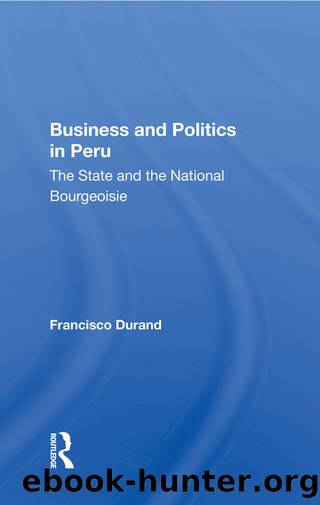Business and Politics in Peru: The State and the National Bourgeoisie by Francisco Durand

Author:Francisco Durand [Durand, Francisco]
Language: eng
Format: epub
Tags: History, General, Latin America
ISBN: 9780813384726
Google: wj21AAAAIAAJ
Goodreads: 5191991
Publisher: Westview Press
Published: 1994-01-11T00:00:00+00:00
The Economic Recession
Several factors (both external and internal) dramatically narrowed the government's economic room to maneuver and in the second half of 1983 a deep and generalized economic recession took place. The economic indicators were negative for all economic sectors. The GNP averaged a growth rate of -12 percent.3
There were a number of critical external factors that got combined to accelerate and deepen the recession: deterioration of the terms of trade, increasing interest rates and lack of international credit and foreign investment. The terms of trade, which had improved from 110 to 120 (1977=100) between 1979 and 1980, declined to 108 in 1981 and to 86 in 1982. Interest rates in the international market rose sharply from 1.5 percent in 1980 to 7.7 percent in 1981 and then 8.3 percent in 1982 (Thorp 1984: 84-87). This decrease in terms of trade and increase in interest rates aggravated the country's trade balance. That year, the Latin American debt hit crisis levels in 1982 and private international banks became unwilling to keep providing credit to Latin America, including Peru, a country that was not being adequately rewarded for its "good payer" policy. The lack of interest in the Peruvian economy shown by foreign investors, and the deterioration in terms of trade, meant that the exporting sector was unable to serve as an engine for economic growth. So evident was their situation that the mining sector was also calling (together with manufacturing industrialists of several branches) for "emergency plans." The mining industry was heavily indebted and also suffered a dramatic decline in earnings.
Internal factors, such as a natural disaster and a recession in the domestic market, helped to aggravate the situation. In 1983, the El Niõo sea current changed its pattern and negatively affected fishing and agriculture by provoking heavy rains and an equally destructive heat wave. The fishing industry lost US$10 million and the sugar and cotton industry lost US$42 million (Thorp 1984: 100; Iguiñiz 1986: 317-321). This natural disaster also damaged the country's infrastructure. The manufacturing sector, which suffered the combined effects of a loss in purchasing power and unequal competition with foreign manufactured goods, registered the highest negative growth rates in the overall economy: -16 percent. The state's fiscal difficulties and a decline in the demand for private and public housing, led to a recession in construction. The banking system, which initially benefited from high interest rates and from profits accumulated by speculation with the exchange rate, became concerned with their clients' mounting debts. Some small banks (Surmebank, Banco de la Industria y la Constructión, Banco Comerical) went bankrupt as a result of a high level of concentration of credits to firms having economic difficulties. These bankruptcies, in turn, generated panic in the business sector (Sifuentes 1988:50).
This unexpected turn of events made the weak national bourgeoisie politically powerful and the industrialists a key player in the political arena. The position of the different fractions of the national bourgeoisie started to change in this context. The recession was so deep, and
Download
This site does not store any files on its server. We only index and link to content provided by other sites. Please contact the content providers to delete copyright contents if any and email us, we'll remove relevant links or contents immediately.
Spell It Out by David Crystal(36016)
Life for Me Ain't Been No Crystal Stair by Susan Sheehan(35715)
Cecilia; Or, Memoirs of an Heiress — Volume 1 by Fanny Burney(32402)
Cecilia; Or, Memoirs of an Heiress — Volume 3 by Fanny Burney(31796)
Cecilia; Or, Memoirs of an Heiress — Volume 2 by Fanny Burney(31769)
The Great Music City by Andrea Baker(31237)
Professional Troublemaker by Luvvie Ajayi Jones(29565)
We're Going to Need More Wine by Gabrielle Union(18935)
The Secret History by Donna Tartt(18795)
Twilight of the Idols With the Antichrist and Ecce Homo by Friedrich Nietzsche(18472)
All the Missing Girls by Megan Miranda(15461)
Cat's cradle by Kurt Vonnegut(15135)
Pimp by Iceberg Slim(14286)
Bombshells: Glamour Girls of a Lifetime by Sullivan Steve(13946)
Talking to Strangers by Malcolm Gladwell(13170)
Norse Mythology by Gaiman Neil(13160)
Fifty Shades Freed by E L James(13140)
For the Love of Europe by Rick Steves(12539)
The Social Justice Warrior Handbook by Lisa De Pasquale(12111)
